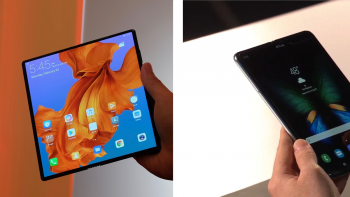
5 reasons you should buy the Huawei Mate X over the Samsung Galaxy Fold
In the space of a week, the world now has two foldable smartphones. Both Samsung and Huawei have entered a market that seemed like a futuristic dream with the Galaxy Fold and Mate X, respectively.
While the devices share a common theme of foldable displays to reveal a larger screen, that’s about where the similarities end. The Samsung Galaxy Fold and Huawei Mate X are two very different implementations of a folding phone, and here are 5 reasons why we think Huawei has taken the lead over Samsung.
No notch
In order to have a camera on the larger screen when the device is unfolded, Samsung has created what can only be described as the largest notch every produced. The off-center cut-out would appear to make watching a full-screen video an unnecessary obstacle. This has to be caveated with the notion that we’ve not had hands-on with the Samsung Fold, but the obtrusion suggests the experience will be worse than current notches.
The Huawei Mate X, on the other hand, has a notch-less display because Huawei decided that to take selfies, one would use one of the existing cameras on the other side of the device in folded mode. This is a much better implementation and means the Mate X has a better display experience.
Full-screen displays
Because of the lack of a notch on the Huawei Mate X, the device achieves a full-screen 8-inch unfolded display at a resolution of 2480 x 2200, compared to the Galaxy Fold’s 7.3-inch 1536 x 2152 display. The display on the Mate X is much more aligned to what you would expect from a foldable screen experience for immersive media consumption.
Folding design
The way in which the two devices fold is the area in which the Mate X and Galaxy Fold differ most. Samsung opted for, what looks like, a very sturdy mechanical mechanism that locks in place, much like a laptop hinge. This means that the Galaxy X folds inwards like a book, which means that the two screens never actually touch and rest with a small gap between the screens at the hinge. The Mate X folds the other way, truly bending the display in half. This creates an actual foldable display but creates a very real concern for the longevity of the screen folding in half to create creases, whereas the Galaxy X doesn’t fold the display directly. However, as far as the implementation of a foldable display goes, assuming Huawei have addresses the durability concerns, the Mate X does it in a way more consistent to what is expected with a foldable smartphone.
Bigger battery
More displays mean a larger drain on the battery, so the larger capacity on the Mate X will help that screen on time. The difference is minimal, but the Galaxy Fold has a 4380mAh battery, while the Mate X has a 4500mAh battery. Also, the Galaxy Fold technically has three displays to power, whereas the Mate X has a larger but single screen, so arguably will draw less power.
Design
While both foldable smartphones feel like beta devices that will naturally mature as the years’ progress, when compared directly, the Mate X is more consistent with how a device of this type should look. The slimmer profile of 10.8mm when folded compared to the 17mm of the Galaxy Fold would suggest the Mate X is much easier and pleasant to hold. Huawei also seems to have put more thought into how a foldable device should be used, providing a superior media experience with the larger display and omitting the camera in favor of the hardware on the back of the device.
Roundup
The launch of the Mate X showed that Samsung hasn’t got the market cornered, and while the Galaxy Fold is an incredible showcase of engineering, the Mate X definitely will give it a run for its money. As mentioned, both devices are nothing more than beta releases for the company to claim it was first to market, and I wouldn’t recommend running out to buy either at well over $2000 a piece, but it gives a good insight into where companies are going, and I’m excited.